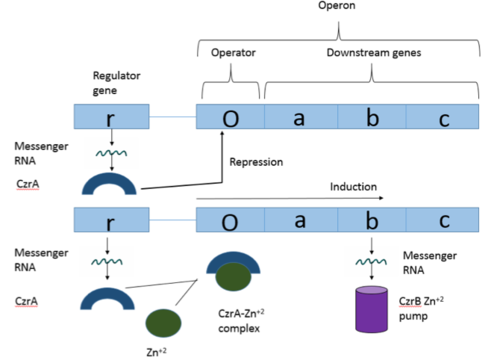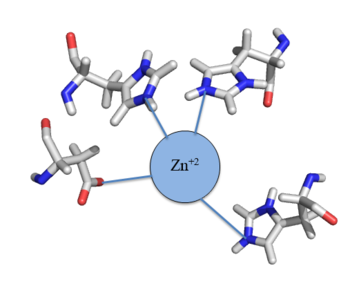Sandbox Reserved 1053
From Proteopedia
(Difference between revisions)
| Line 18: | Line 18: | ||
Ser54, Ser57, and His58 are the primary residues involved in <scene name='69/694220/2kjb_colored/3'>DNA interaction</scene> with Czr A <ref name="critical"/>. These residues are likely to interact with the 5'-TGAA sequence found in the half-site of the DNA, where the α4 helices (green) <scene name='69/694219/Czra_with_dna/2'>form an interaction with DNA</scene> (Figure 3). Binding of two Zn<sup>+2</sup> ions <scene name='69/694220/Dna_residues_when_inhibited/2'>pushes these residues out of their DNA binding conformation</scene>. Additionally, Val42 and Gln53 (lime green) are involved in the <scene name='69/694220/Val_42_and_gln_53/1'>DNA binding pocket</scene>. | Ser54, Ser57, and His58 are the primary residues involved in <scene name='69/694220/2kjb_colored/3'>DNA interaction</scene> with Czr A <ref name="critical"/>. These residues are likely to interact with the 5'-TGAA sequence found in the half-site of the DNA, where the α4 helices (green) <scene name='69/694219/Czra_with_dna/2'>form an interaction with DNA</scene> (Figure 3). Binding of two Zn<sup>+2</sup> ions <scene name='69/694220/Dna_residues_when_inhibited/2'>pushes these residues out of their DNA binding conformation</scene>. Additionally, Val42 and Gln53 (lime green) are involved in the <scene name='69/694220/Val_42_and_gln_53/1'>DNA binding pocket</scene>. | ||
| - | The <scene name='69/694220/Dna_binding_residues/2'>residues directly involved in binding to DNA</scene> Gln53 and Val42 (aqua) as well as the Ser54, Ser57, and His58 (lime) have been individually mutated to Ala, and DNA binding experiments were performed<ref name="critical"/>. Compared to wild type Czr A, Gln53Ala and Val42Ala variants displayed an 11-fold and 160-fold decrease in K<sub>a</sub>, respectively. Mutations to the main DNA interaction sites Ser54, Ser57, and His58 result in drastic loss of binding similar to the inhibited non-DNA binding conformational state, suggesting that these residues are essential to binding DNA. While the conformational change that occurs from the Zinc bound state to the DNA bound state is small,the α4 helices (shown in green in Figure 2) are slightly shifted. The loss of DNA binding in the mutagenesis experiments in combination with the lack of any other major physical changes between these two states further suggests that the α4 helices are the location of DNA binding in Czr A. A computational model of CzrA with DNA bound (not available in the PDB) has been since been published. | + | The <scene name='69/694220/Dna_binding_residues/2'>residues directly involved in binding to DNA</scene> Gln53 and Val42 (aqua) as well as the Ser54, Ser57, and His58 (lime) have been individually mutated to Ala, and DNA binding experiments were performed<ref name="critical"/>. Compared to wild type Czr A, Gln53Ala and Val42Ala variants displayed an 11-fold and 160-fold decrease in K<sub>a</sub>, respectively. Mutations to the main DNA interaction sites Ser54, Ser57, and His58 result in drastic loss of binding similar to the inhibited non-DNA binding conformational state, suggesting that these residues are essential to binding DNA. While the conformational change that occurs from the Zinc bound state to the DNA bound state is small,the α4 helices (shown in green in Figure 2) are slightly shifted. The loss of DNA binding in the mutagenesis experiments in combination with the lack of any other major physical changes between these two states further suggests that the α4 helices are the location of DNA binding in Czr A. A computational model of CzrA with DNA bound (not available in the PDB) has been since been published<ref>PMID:22007899</ref>. |
| - | [[Image:800px-DNABound Final.fw.png CROPPED.fw.png|750px|thumb|center| Figure 3: Two views of Czr A bound to DNA. A segment of DNA is shown in orange with the | + | [[Image:800px-DNABound Final.fw.png CROPPED.fw.png|750px|thumb|center| Figure 3: Two views of Czr A bound to DNA. A segment of DNA is shown in orange with the α5 helices displayed in red and the α4 helices shown in green.]] |
| - | + | ||
== Zinc Binding Site== | == Zinc Binding Site== | ||
Revision as of 01:13, 19 January 2018
Zinc Dependent Transcriptional Repressor of the Czr operon (CzrA)
| |||||||||||
References
- ↑ 1.0 1.1 1.2 1.3 Arunkumar A., Campanello G., Giedroc D. (2009). Solution Structure of a paradigm ArsR family zinc sensor in the DNA-bound state. PNAS 106:43 18177-18182.
- ↑ Chakravorty DK, Wang B, Lee CW, Giedroc DP, Merz KM Jr. Simulations of allosteric motions in the zinc sensor CzrA. J Am Chem Soc. 2012 Feb 22;134(7):3367-76. doi: 10.1021/ja208047b. Epub 2011 Nov , 14. PMID:22007899 doi:http://dx.doi.org/10.1021/ja208047b
- ↑ MacPherson S, Larochelle M, Turcotte B. A fungal family of transcriptional regulators: the zinc cluster proteins. Microbiol Mol Biol Rev. 2006 Sep;70(3):583-604. PMID:16959962 doi:http://dx.doi.org/10.1128/MMBR.00015-06
- ↑ Miller J, McLachlan AD, Klug A. Repetitive zinc-binding domains in the protein transcription factor IIIA from Xenopus oocytes. EMBO J. 1985 Jun 4;4(6):1609-1614.
- ↑ Grossoehme NE, Giedroc DP. Energetics of allosteric negative coupling in the zinc sensor S. aureus CzrA. J Am Chem Soc. 2009 Dec 16;131(49):17860-70. doi: 10.1021/ja906131b. PMID:19995076 doi:http://dx.doi.org/10.1021/ja906131b




